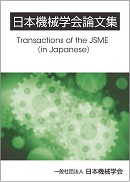85 巻, 878 号
選択された号の論文の29件中1~29を表示しています
- |<
- <
- 1
- >
- >|
TRANSLOG2018 & J-RAIL2018
-
2019 年 85 巻 878 号 p. 18-00506
発行日: 2019年
公開日: 2019/10/25
[早期公開] 公開日: 2019/04/26PDF形式でダウンロード (2275K) -
2019 年 85 巻 878 号 p. 19-00004
発行日: 2019年
公開日: 2019/10/25
[早期公開] 公開日: 2019/05/22PDF形式でダウンロード (2532K) -
2019 年 85 巻 878 号 p. 19-00051
発行日: 2019年
公開日: 2019/10/25
[早期公開] 公開日: 2019/07/26PDF形式でダウンロード (1832K) -
2019 年 85 巻 878 号 p. 19-00055
発行日: 2019年
公開日: 2019/10/25
[早期公開] 公開日: 2019/09/05PDF形式でダウンロード (2867K) -
2019 年 85 巻 878 号 p. 19-00056
発行日: 2019年
公開日: 2019/10/25
[早期公開] 公開日: 2019/07/26PDF形式でダウンロード (1978K) -
2019 年 85 巻 878 号 p. 19-00076
発行日: 2019年
公開日: 2019/10/25
[早期公開] 公開日: 2019/09/04PDF形式でダウンロード (1118K) -
2019 年 85 巻 878 号 p. 19-00079
発行日: 2019年
公開日: 2019/10/25
[早期公開] 公開日: 2019/09/10PDF形式でダウンロード (1379K) -
2019 年 85 巻 878 号 p. 19-00083
発行日: 2019年
公開日: 2019/10/25
[早期公開] 公開日: 2019/09/04PDF形式でダウンロード (3042K) -
2019 年 85 巻 878 号 p. 19-00088
発行日: 2019年
公開日: 2019/10/25
[早期公開] 公開日: 2019/07/26PDF形式でダウンロード (2811K) -
2019 年 85 巻 878 号 p. 19-00089
発行日: 2019年
公開日: 2019/10/25
[早期公開] 公開日: 2019/09/04PDF形式でダウンロード (3778K) -
2019 年 85 巻 878 号 p. 19-00090
発行日: 2019年
公開日: 2019/10/25
[早期公開] 公開日: 2019/07/26PDF形式でダウンロード (2198K) -
2019 年 85 巻 878 号 p. 19-00091
発行日: 2019年
公開日: 2019/10/25
[早期公開] 公開日: 2019/09/05PDF形式でダウンロード (2867K) -
2019 年 85 巻 878 号 p. 19-00093
発行日: 2019年
公開日: 2019/10/25
[早期公開] 公開日: 2019/07/26PDF形式でダウンロード (2997K) -
2019 年 85 巻 878 号 p. 19-00095
発行日: 2019年
公開日: 2019/10/25
[早期公開] 公開日: 2019/09/05PDF形式でダウンロード (1775K)
材料力学,機械材料,材料加工
-
2019 年 85 巻 878 号 p. 18-00428
発行日: 2019年
公開日: 2019/10/25
[早期公開] 公開日: 2019/10/01PDF形式でダウンロード (1834K) -
2019 年 85 巻 878 号 p. 18-00436
発行日: 2019年
公開日: 2019/10/25
[早期公開] 公開日: 2019/10/01PDF形式でダウンロード (1996K)
流体工学,流体機械
-
2019 年 85 巻 878 号 p. 19-00198
発行日: 2019年
公開日: 2019/10/25
[早期公開] 公開日: 2019/10/02PDF形式でダウンロード (2305K) -
2019 年 85 巻 878 号 p. 19-00217
発行日: 2019年
公開日: 2019/10/25
[早期公開] 公開日: 2019/09/17PDF形式でダウンロード (2251K) -
2019 年 85 巻 878 号 p. 19-00294
発行日: 2019年
公開日: 2019/10/25
[早期公開] 公開日: 2019/10/08PDF形式でダウンロード (4179K)
機械力学,計測,自動制御,ロボティクス,メカトロニクス
-
2019 年 85 巻 878 号 p. 18-00498
発行日: 2019年
公開日: 2019/10/25
[早期公開] 公開日: 2019/09/18PDF形式でダウンロード (6457K) -
2019 年 85 巻 878 号 p. 19-00154
発行日: 2019年
公開日: 2019/10/25
[早期公開] 公開日: 2019/09/18PDF形式でダウンロード (6737K) -
2019 年 85 巻 878 号 p. 19-00185
発行日: 2019年
公開日: 2019/10/25
[早期公開] 公開日: 2019/09/12PDF形式でダウンロード (2084K) -
2019 年 85 巻 878 号 p. 19-00231
発行日: 2019年
公開日: 2019/10/25
[早期公開] 公開日: 2019/09/12PDF形式でダウンロード (2374K)
設計,機素・潤滑,情報・知能,製造,システム
-
2019 年 85 巻 878 号 p. 19-00161
発行日: 2019年
公開日: 2019/10/25
[早期公開] 公開日: 2019/09/27PDF形式でダウンロード (1513K) -
2019 年 85 巻 878 号 p. 19-00254
発行日: 2019年
公開日: 2019/10/25
[早期公開] 公開日: 2019/10/01PDF形式でダウンロード (3187K) -
2019 年 85 巻 878 号 p. 19-00273
発行日: 2019年
公開日: 2019/10/25
[早期公開] 公開日: 2019/10/03PDF形式でダウンロード (2858K) -
2019 年 85 巻 878 号 p. 19-00275
発行日: 2019年
公開日: 2019/10/25
[早期公開] 公開日: 2019/09/20PDF形式でダウンロード (1776K)
生体工学,医工学,スポーツ工学,人間工学
-
2019 年 85 巻 878 号 p. 19-00191
発行日: 2019年
公開日: 2019/10/25
[早期公開] 公開日: 2019/09/11PDF形式でダウンロード (2788K)
交通・物流
-
2019 年 85 巻 878 号 p. 19-00221
発行日: 2019年
公開日: 2019/10/25
[早期公開] 公開日: 2019/09/13PDF形式でダウンロード (2894K)
- |<
- <
- 1
- >
- >|
